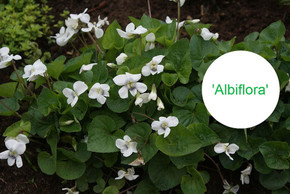
Viola sororia forma priceana - CONFEDERATE VIOLET
The double-colored Common Blue Violet, or Confederate Violet, is a natural bi-colored form of the small native wildflower. The flowers start in early spring and can last well into the summer months, potentially reblooming in late summer or autumn. The flowers are big, about 1" wide.
It forms small clumps/rosettes of partially evergreen leaves. Can be used as groundcover in shaded areas, edges of woodland gardens, woodland gardens, in the front of naturalistic borders or naturalized in the lawn (they survive mowing if it is not too low).
This small perennial spreads slowly with short rhizomes and stays in dense clumps, but in ideal conditions can self-seed too much and look "weedy". It is adaptable to many soil types, including clay. Tolerates some shorter droughts too.
The flowers are not often visited by insects, but the seeds are partially distributed by ants. Various upland gamebirds and small mammals occasionally eat the seeds, including the Wild Turkey, Bobwhite, Mourning Dove, and White-Footed Mouse. Wild Turkeys can also eat the leaves and fleshy roots of Viola spp. (violets). Deer and rabbit may occasionally feed on leaves, but it is not a preferable food for them.
Blooming Time: April to June
Size: 4-6" tall x 6" wide
USDA Zones: 3 to 9
Culture: prefers half shade, or places with a little shade during the day (it will tolerate full sun if the soil stays moist), average soil
Moisture Needs: average
Origin: native to the whole eastern part of the USA (USDA distribution map), naturally occurring in moist blackland prairies, savannas, open woods, shaded banks and borders of rivers, lakes and creeks. It can also be found in waste areas and urban lawns and landscapes.
Deer/Rabbit Resistant: partially yes / partially yes
Attracts Butterflies or Pollinators: yes / yes, they attract some bees (Mason, Halictid), skippers, Syrphid flies, and other insects. The leaves are an important food source for the caterpillars of many Fritillary butterflies (Diana, Variegated, Aphrodite, Meadow and Silver-Border Fritillary).
Attracts Hummingbirds: no
Pot Size: square 3.5" x 4" deep perennial pot
Plant Combinations: potential companions include Aquilegia canadensis, Asarum, Phlox divaricata, Chrysogonum virginianum, Geranium maculatum, Iris cristata, Polygogonatum, Silene regia, Smilacina, Spigelia marilandica or lower grasses or sedges like Carex pennsylvanica.

Viola sororia forma priceana - CONFEDERATE VIOLET
The double-colored Common Blue Violet, or Confederate Violet, is a natural bi-colored form of the small native wildflower. The flowers start in early spring and can last well into the summer months, potentially reblooming in late summer or autumn. The flowers are big, about 1" wide.
It forms small clumps/rosettes of partially evergreen leaves. Can be used as groundcover in shaded areas, edges of woodland gardens, woodland gardens, in the front of naturalistic borders or naturalized in the lawn (they survive mowing if it is not too low).
This small perennial spreads slowly with short rhizomes and stays in dense clumps, but in ideal conditions can self-seed too much and look "weedy". It is adaptable to many soil types, including clay. Tolerates some shorter droughts too.
The flowers are not often visited by insects, but the seeds are partially distributed by ants. Various upland gamebirds and small mammals occasionally eat the seeds, including the Wild Turkey, Bobwhite, Mourning Dove, and White-Footed Mouse. Wild Turkeys can also eat the leaves and fleshy roots of Viola spp. (violets). Deer and rabbit may occasionally feed on leaves, but it is not a preferable food for them.
Blooming Time: April to June
Size: 4-6" tall x 6" wide
USDA Zones: 3 to 9
Culture: prefers half shade, or places with a little shade during the day (it will tolerate full sun if the soil stays moist), average soil
Moisture Needs: average
Origin: native to the whole eastern part of the USA (USDA distribution map), naturally occurring in moist blackland prairies, savannas, open woods, shaded banks and borders of rivers, lakes and creeks. It can also be found in waste areas and urban lawns and landscapes.
Deer/Rabbit Resistant: partially yes / partially yes
Attracts Butterflies or Pollinators: yes / yes, they attract some bees (Mason, Halictid), skippers, Syrphid flies, and other insects. The leaves are an important food source for the caterpillars of many Fritillary butterflies (Diana, Variegated, Aphrodite, Meadow and Silver-Border Fritillary).
Attracts Hummingbirds: no
Pot Size: square 3.5" x 4" deep perennial pot
Plant Combinations: potential companions include Aquilegia canadensis, Asarum, Phlox divaricata, Chrysogonum virginianum, Geranium maculatum, Iris cristata, Polygogonatum, Silene regia, Smilacina, Spigelia marilandica or lower grasses or sedges like Carex pennsylvanica.
Customer Reviews
-
Great Quality
Packed professionally. Plant quality 5 stars!









